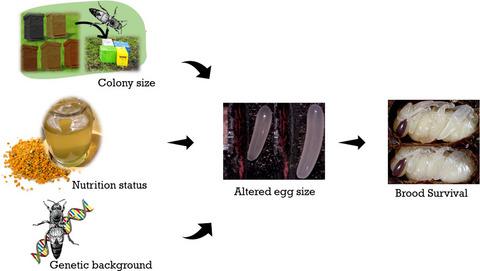当前位置:
X-MOL 学术
›
J. Evol. Biol.
›
论文详情
Our official English website, www.x-mol.net, welcomes your feedback! (Note: you will need to create a separate account there.)
Egg‐size plasticity in Apis mellifera : honey bee queens alter egg size in response to both genetic and environmental factors
Journal of Evolutionary Biology ( IF 2.1 ) Pub Date : 2020-02-03 , DOI: 10.1111/jeb.13589 Esmaeil Amiri 1, 2 , Kevin Le 1 , Carlos Vega Melendez 1 , Micheline K Strand 3 , David R Tarpy 2 , Olav Rueppell 1
Journal of Evolutionary Biology ( IF 2.1 ) Pub Date : 2020-02-03 , DOI: 10.1111/jeb.13589 Esmaeil Amiri 1, 2 , Kevin Le 1 , Carlos Vega Melendez 1 , Micheline K Strand 3 , David R Tarpy 2 , Olav Rueppell 1
Affiliation

|
Social evolution has led to distinct life‐history patterns in social insects, but many colony‐level and individual traits, such as egg size, are not sufficiently understood. Thus, a series of experiments was performed to study the effects of genotypes, colony size and colony nutrition on variation in egg size produced by honey bee (Apis mellifera) queens. Queens from different genetic stocks produced significantly different egg sizes under similar environmental conditions, indicating standing genetic variation for egg size that allows for adaptive evolutionary change. Further investigations revealed that eggs produced by queens in large colonies were consistently smaller than eggs produced in small colonies, and queens dynamically adjusted egg size in relation to colony size. Similarly, queens increased egg size in response to food deprivation. These results could not be solely explained by different numbers of eggs produced in the different circumstances but instead seem to reflect an active adjustment of resource allocation by the queen in response to colony conditions. As a result, larger eggs experienced higher subsequent survival than smaller eggs, suggesting that honey bee queens might increase egg size under unfavourable conditions to enhance brood survival and to minimize costly brood care of eggs that fail to successfully develop, and thus conserve energy at the colony level. The extensive plasticity and genetic variation of egg size in honey bees has important implications for understanding life‐history evolution in a social context and implies this neglected life‐history stage in honey bees may have trans‐generational effects.
中文翻译:

蜜蜂的蛋大小可塑性:蜂后根据遗传和环境因素改变蛋大小
社会进化导致了社会昆虫不同的生活史模式,但许多群体水平和个体特征,如鸡蛋大小,尚未得到充分了解。因此,进行了一系列实验来研究基因型、菌落大小和菌落营养对蜜蜂(Apis mellifera)蜂王产卵大小变化的影响。来自不同遗传种群的皇后在相似的环境条件下产生了显着不同的卵大小,表明卵大小的遗传变异允许适应性进化变化。进一步的调查显示,大群体中的蜂王产卵始终小于小群体中的卵,并且蜂后会根据群体大小动态调整卵大小。同样,皇后因食物缺乏而增加了蛋的大小。这些结果不能仅仅由不同情况下不同数量的卵来解释,而是似乎反映了女王根据群体条件对资源分配的积极调整。因此,较大的鸡蛋比较小的鸡蛋经历了更高的后续存活率,这表明蜂后可能会在不利条件下增加鸡蛋大小以提高育雏存活率并最大限度地减少未能成功发育的鸡蛋的昂贵的育雏护理,从而节省能量殖民地级别。蜜蜂卵大小的广泛可塑性和遗传变异对于理解社会背景下的生活史进化具有重要意义,并暗示这种被忽视的蜜蜂生活史阶段可能具有跨代效应。
更新日期:2020-02-03
中文翻译:

蜜蜂的蛋大小可塑性:蜂后根据遗传和环境因素改变蛋大小
社会进化导致了社会昆虫不同的生活史模式,但许多群体水平和个体特征,如鸡蛋大小,尚未得到充分了解。因此,进行了一系列实验来研究基因型、菌落大小和菌落营养对蜜蜂(Apis mellifera)蜂王产卵大小变化的影响。来自不同遗传种群的皇后在相似的环境条件下产生了显着不同的卵大小,表明卵大小的遗传变异允许适应性进化变化。进一步的调查显示,大群体中的蜂王产卵始终小于小群体中的卵,并且蜂后会根据群体大小动态调整卵大小。同样,皇后因食物缺乏而增加了蛋的大小。这些结果不能仅仅由不同情况下不同数量的卵来解释,而是似乎反映了女王根据群体条件对资源分配的积极调整。因此,较大的鸡蛋比较小的鸡蛋经历了更高的后续存活率,这表明蜂后可能会在不利条件下增加鸡蛋大小以提高育雏存活率并最大限度地减少未能成功发育的鸡蛋的昂贵的育雏护理,从而节省能量殖民地级别。蜜蜂卵大小的广泛可塑性和遗传变异对于理解社会背景下的生活史进化具有重要意义,并暗示这种被忽视的蜜蜂生活史阶段可能具有跨代效应。



























 京公网安备 11010802027423号
京公网安备 11010802027423号